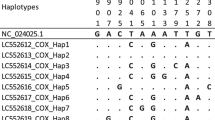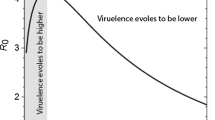Abstract
This study was conducted to investigate the status and population dynamics of porcine circovirus type 2 (PCV2) in Korea and to assess the molecular evolutionary pattern of the two biologically important, overlapping open reading frames, the ORF1 and ORF3 genes. A wide range of PCV2 genomic sequences (entire genome, ORF1, ORF2 and ORF3) collected between 2001 and 2010 were analyzed using the Bayesian Markov chain Monte Carlo and maximum-likelihood approaches. These techniques identified the PCV2d genotype and the 2Ek cluster of PCV2a in Korea for the first time. Second, the genotypic shift of PCV2b dominating over PCV2a likely occurred between 2002 and 2004 due to a population expansion of PCV2b. In the context of positive Darwinian selection, the results uncovered independent evolutionary patterns in the ORF3 gene compared to the overlapping ORF1 gene and new sites in the viral ORFs/proteins that might relate to differences in the biological properties of the PCV2 groups.





Similar content being viewed by others
References
Allemandou A, Grasland B, Hernandez Nignol AC, Keranflec’h A, Cariolet R, Jestin A (2011) Modification of PCV-2 virulence by substitution of the genogroup motif of the capsid protein. Vet Res 42:54
An DJ, Roh IS, Song DS, Park CK, Park BK (2007) Phylogenetic characterization of porcine circovirus type 2 in PMWS and PDNS Korean pigs between 1999 and 2006. Virus Res 129:115–122
Chaiyakul M, Hsu K, Dardari R, Marshall F, Czub M (2010) Cytotoxicity of ORF3 proteins from a nonpathogenic and a pathogenic Porcine circovirus. J Virol 84:11440–11447
Cheung AK (2003) The essential and nonessential transcription units for viral protein synthesis and DNA replication of porcine circovirus type 2. Virology 313:452–459
Cheung AK (2003) Transcriptional analysis of Porcine circovirus type 2. Virology 305:168–180
Cheung AK, Lager KM, Kohutyuk OI, Vincent AL, Henry SC, Baker RB, Rowland RR, Dunham AG (2007) Detection of two porcine circovirus type 2 genotypic groups in United States swine herds. Arch Virol 152:1035–1044
Chirico N, Vianelli A, Belshaw R (2010) Why genes overlap in viruses. Proc Royal Soc B Biol Sci. doi:10.1098/rspb.2010.1052
Choi C, Chae C, Clark EG (2000) Porcine postweaning multisystemic wasting syndrome in Korean pig: detection of porcine circovirus 2 infection by immunohistochemistry and polymerase chain reaction. J Vet Diagn Invest 12:151–153
Cortey M, Pileri E, Sibila M, Pujols J, Balasch M, Plana J, Segales J (2010) Genotypic shift of porcine circovirus type 2 from PCV-2a to PCV-2b in Spain from 1985 to 2008. Vet J. doi:10.1016/j.tvjl.2009.12.023
Drummon A, Pybus OG, Rambaut A (2003) Inference of viral evolutionary rates from molecular sequences. Advances in parasitology. Academic Press, London, pp 331–358
Drummond A, Rambaut A (2007) BEAST: Bayesian evolutionary analysis by sampling trees. BMC Evol Biol 7:214
Drummond AJ, Rambaut A, Shapiro B, Pybus OG (2005) Bayesian coalescent inference of past population dynamics from molecular sequences. Mol Biol Evol 22:1185–1192
Dupont K, Nielsen EO, Bækbo P, Larsen LE (2008) Genomic analysis of PCV2 isolates from Danish archives and a current PMWS case-control study supports a shift in genotypes with time. Vet Microbiol 128:56–64
Fenaux M, Halbur PG, Gill M, Toth TE, Meng XJ (2000) Genetic characterization of type 2 Porcine circovirus (PCV-2) from pigs with Postweaning multisystemic wasting syndrome in different geographic regions of North America and development of a differential PCR-restriction fragment length polymorphism assay to detect and differentiate between infections with PCV-1 and PCV-2. J Clin Microbiol 38:2494–2503
Fenaux M, Opriessnig T, Halbur PG, Elvinger F, Meng XJ (2004) Two amino acid mutations in the capsid protein of type 2 Porcine circovirus (PCV2) enhanced PCV2 replication in vitro and attenuated the virus in vivo. J Virol 78:13440–13446
Firth C, Charleston MA, Duffy S, Shapiro B, Holmes EC (2009) Insights into the evolutionary history of an emerging livestock pathogen: porcine circovirus 2. J Virol 83:12813–12821
Grierson SS, King DP, Sandvik T, Hicks D, Spencer Y, Drew TW, Banks M (2004) Detection and genetic typing of type 2 porcine circoviruses in archived pig tissues from the UK. Arch Virol 149:1171–1183
Guo L, Lu Y, Wei Y, Huang L, Liu C (2010) Porcine circovirus type 2 (PCV2): genetic variation and newly emerging genotypes in China. Virol J 7:273
Hall TA (1999) BioEdit: a user-friendly biological sequence alignment editor and analysis program for Windows 95/98/NT. Nucl Acids Symp Ser 41:95–98
Hamel AL, Lin LL, Nayar GPS (1998) Nucleotide sequence of porcine circovirus associated with postweaning multisystemic wasting syndrome in pigs. J Virol 72:5262–5267
Hughes AL, Hughes MAK (2005) Patterns of nucleotide difference in overlapping and non-overlapping reading frames of papillomavirus genomes. Virus Res 113:81–88
Juhan NM, LeRoith T, Opriessnig T, Meng XJ (2010) The open reading frame 3 (ORF3) of porcine circovirus type 2 (PCV2) is dispensable for virus infection but evidence of reduced pathogenicity is limited in pigs infected by an ORF3-null PCV2 mutant. Virus Res 147:60–66
Karuppannan AK, Jong MH, Lee SH, Zhu Y, Selvaraj M, Lau J, Jia Q, Kwang J (2009) Attenuation of porcine circovirus 2 in SPF piglets by abrogation of ORF3 function. Virology 383:338–347
Karuppannan AK, Kwang J (2011) ORF3 of porcine circovirus 2 enhances the in vitro and in vivo spread of the of the virus. Virology 410:248–256
Kim HH, Park SI, Hyun BH, Park SJ, Jeong YJ, Shin DJ, Chun YH, Hosmillo M, Lee BJ, Kang MI, Cho KO (2009) Genetic diversity of porcine circovirus type 2 in Korean pigs with postweaning multisystemic wasting syndrome during 2005–2007. J Vet Med Sci 71:349–353
Kim HK, Luo Y, Moon HJ, Park SJ, Keum HO, Rho S, Park BK (2009) Phylogenetic and recombination analysis of genomic sequences of PCV2 isolated in Korea. Virus Genes 39:352–358
Larkin MA, Blackshields G, Brown NP, Chenna R, McGettigan PA, McWilliam H, Valentin F, Wallace IM, Wilm A, Lopez R, Thompson JD, Gibson TJ, Higgins DG (2007) Clustal W and Clustal X version 2.0. Bioinformatics 23:2947–2948
Liu J, Chen I, Kwang J (2005) Characterization of a previously unidentified viral protein in Porcine circovirus type 2- infected cells and its role in virus-induced apoptosis. J Virol 79:8262–8274
Liu J, Chen I, Du Q, Chua H, Kwang J (2006) The ORF3 protein of Porcine circovirus type 2 is involved in viral pathogenesis in vivo. J Virol 80:5065–5073
Nawagitgul P, Morozov I, Bolin SR, Harms PA, Sorden SD, Paul PS (2000) Open reading frame 2 of porcine circovirus type 2 encodes a major capsid protein. J Gen Virol 81:2281–2287
Olvera A, Cortey M, Segales J (2007) Molecular evolution of porcine circovirus type 2 genomes: phylogeny and clonality. Virology 357:175–185
Opriessnig T, Meng XJ, Halbur PG (2007) Porcine Circovirus Type 2 associated disease: Update on current terminology, clinical manifestations, pathogenesis, diagnosis, and intervention strategies. J Vet Diagn Invest 19:591–615
Opriessnig T, Ramamoorthy S, Madson DM, Patterson AR, Pal N, Carman S, Meng XJ, Halbur PG (2008) Differences in virulence among porcine circovirus type 2 isolates are unrelated to cluster type 2a or 2b and prior infection provides heterologous protection. J Gen Virol 89:2482–2491
Rodriguez-Arrioja GM, Segales J, Rosell C, Rovira A, Pujols J, Plana-Duran J, Domingo M (2003) Retrospective study on porcine circovirus type 2 infection in pigs from 1985 to 1997 in Spain. J Vet Med B Infect Dis Vet Public Health 50:99–101
Stevenson LS, Gilpin DF, Douglas A, McNeilly F, McNair I, Adair BM, Allan GM (2007) T lymphocyte epitope mapping of Porcine circovirus type 2. Viral Immunol 20:389–398
Timmusk S, Wallgren P, Brunborg I, Wikström F, Allan G, Meehan B, McMenamy M, McNeilly F, Fuxler L, Belák K, Põdersoo D, Saar T, Berg M, Fossum C (2008) Phylogenetic analysis of porcine circovirus type 2 (PCV2) pre- and post-epizootic postweaning multisystemic wasting syndrome (PMWS). Virus Genes 36:509–520
Yang JS, Song DS, Kim SY, Lyoo KS, Park BK (2003) Detection of porcine circovirus type 2 in feces of pigs with or without enteric disease by polymerase chain reaction. J Vet Diagn Invest 15:369–373
Yang Z (2007) PAML 4: phylogenetic analysis by maximum likelihood. Mol Biol Evol 24:1586–1591
Zaaijer HL, van Hemert FJ, Koppelman MH, Lukashov VV (2007) Independent evolution of overlapping polymerase and surface protein genes of hepatitis B virus. J Gen Virol 88:2137–2143
Author information
Authors and Affiliations
Corresponding author
Rights and permissions
About this article
Cite this article
Nguyen, V.G., Kim, H.K., Moon, H.J. et al. Population dynamics and ORF3 gene evolution of porcine circovirus type 2 circulating in Korea. Arch Virol 157, 799–810 (2012). https://doi.org/10.1007/s00705-012-1234-x
Received:
Accepted:
Published:
Issue Date:
DOI: https://doi.org/10.1007/s00705-012-1234-x




